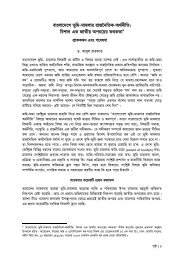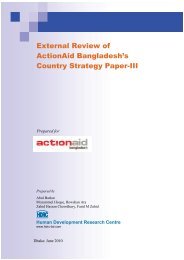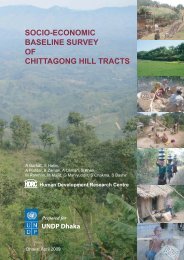08. Costing Essential Services Package An Issue Paper
08. Costing Essential Services Package An Issue Paper
08. Costing Essential Services Package An Issue Paper
Create successful ePaper yourself
Turn your PDF publications into a flip-book with our unique Google optimized e-Paper software.
<strong>Costing</strong> <strong>Essential</strong> <strong>Services</strong> <strong>Package</strong>: <strong>An</strong> <strong>Issue</strong> <strong>Paper</strong> 22<br />
6. ESP <strong>Costing</strong> Review <strong>Issue</strong>s: Outcome of One-to-one Discussions<br />
In order to arrive at a better methodology for ESP costing, the present assignment involved<br />
among others, one-to-one discussions with relevant people. These people were from different<br />
organizations of the government of Bangladesh, donor-agencies and researchers. In all 35<br />
people from these organizations were approached by the research team with a topic guide to<br />
capture their opinions, suggestions and observations. The following is the summary of all those<br />
deliberations between the research team and others. In order to present the outcome of the<br />
discussions in a systematic fashion all the issues discussed have been categorized under eight<br />
major issues of concern and, for each, all possible views, concerns and suggestions have been<br />
delineated below:<br />
<strong>Issue</strong>s of Concern Responses<br />
1. Why a review<br />
on ESP <strong>Costing</strong><br />
has been<br />
undertaken at<br />
this point of<br />
time?<br />
2. Top-down and<br />
bottom-up<br />
approach –<br />
happy match,<br />
or a mismatch.<br />
3. Priority in<br />
resource<br />
allocation for<br />
HPSP,<br />
prioritization<br />
within ESP<br />
components,<br />
and quality<br />
issues.<br />
Very few respondents, with whom the study team interacted, raised this question,<br />
and during discussion with almost all respondents/discussants the position was<br />
cleared. It was established that –<br />
a) Review will lead to methodological improvement in overall ESP costing<br />
and cost-calculations of ESP components,<br />
b) Strengthen the planning-process, both physical and financial and that<br />
annual operational plan(s) will be more realistic;<br />
c) Methodological improvement will bear upon sectoral performance and<br />
greater efficiency. The apprehension that methodological changes in<br />
costing ESP will open-up “pandora box” was not well founded.<br />
It was a consensus that – there is scope for improvement, particularly now, when<br />
the HPSP interventions is in its third year. The best of anything is yet to come!<br />
Some respondents were of the view that uncertainties prevail in resource allocation<br />
for ESP component financing; the top-down approach is somewhat rigid and often<br />
not negotiable – the resource envelope is hardly decided through mutual<br />
consultations; on the other hand, bottom-up approach is flexible, open to discussion<br />
and more open for adjustment. Basically, top-down approach largely depends on<br />
resource availability and national priority etc, but can hardly be firmly predicted wellahead<br />
of time. The bottom-up approach is based more on needs and discussions<br />
amongst stakeholders with the risk of costing projected on the high side. Some<br />
respondents opined that a happy match between the two approaches is hardly<br />
possible, either way to be followed to avoid uncertainties in costing/budgeting.<br />
Moreover, merging of two approaches will be time consuming and might lead to<br />
more dissonance than consensus. However, most respondents disagreed with this<br />
disposition and observed that timely interaction with high policy-level personnel<br />
about resource needs based on sound field survey data about the program<br />
components, the top-down approach would bear fruit and the bottom-up approach<br />
would get more credence than expected. There is need to formulate ways and<br />
means towards happy matchmaking of the two approaches. The most important,<br />
rather critical point is how to generate sufficiently accurate (quality) data and make<br />
them available to the concerned people for specific decision making.<br />
a) Priority in resource allocation by the government and development partners was<br />
re-emphasized. The point was well articulated time and again, but priority for<br />
resources as per requirement did not materialize. Again, some respondents felt<br />
that there should, in the face of resource constraints, be prioritization within ESP<br />
components for resource allocation and utilization. This needs careful<br />
consideration by stakeholders. Stakeholders choices and decision-making may<br />
warrant several short-term pilot studies at the field level. Data generated from<br />
the field would guide the decision-making process for the stake-holders.






